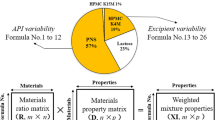Abstract
The purpose of this study was development of diclofenac sodium extended release compressed matrix pellets and optimization using Generalized Regression Neural Network (GRNN). According to Central Composite Design (CCD), ten formulations of diclofenac sodium matrix tablets were prepared. Extended release of diclofenac sodium was acomplished using Carbopol® 71G as matrix substance. The process of direct pelletisation and subsequently compression of the pellets into MUPS tablets was applied in order to investigate a different approach in formulation of matrix systems and to achieve more control of the process factors over the principal response — the release of the drug. The investigated factors were X1 -the percentage of polymer Carbopol® 71 G and X2- crushing strength of the MUPS tablet. In vitro dissolution time profiles at 5 different sampling times were chosen as responses. Results of drug release studies indicate that drug release rates vary between different formulations, with a range of 1 hour to 8 hours of dissolution. The most important impact on the drug release has factor X1 -the percentage of polymer Carbopol® 71 G. The purpose of the applied GRNN was to model the effects of these two causal factors on the in vitro release profile of the diclofenac sodium from compressed matrix pellets. The aim of the study was to optimize drug release in manner wich enables following in vitro release of diclofenac sodium during 8 hours in phosphate buffer: 1 h: 15–40%, 2 h: 25–60%, 4 h: 35–75%, 8 h: >70%.
Similar content being viewed by others
References
Bettini, R., Catellani, P. L., Santi, P., Massimo, G., Peppas, N. A., and Colombo, P., Translocation of drug particles in HPMC matrix gel layer: effect of drug solubility and influence on release rate. J. Control. Release., 70, 383–391 (2001).
Gomez-Carracedo, A., Alvarez-Lorenzo, C., Gomez-Amoza, J. L., and Concheiro, A., Extrusion-spheronization of blends of carbopol 934 and microcristaline cellulose. Drug Dev. Ind. Pharm., 27, 381–391 (2001).
Haslam, J. L., Forbes, A. E., Rork, G. S., Pipkin, T. L., Slade, D. A., and Khossravi, D., Tabletting of controlled release multiparticulates, the effect of millisphere size and protective overcoating. Int. J. Pharm., 173, 233–242 (1998).
Ibric, S., Jovanovic, M., Djuric, Z., Parojcic, J., and Solomun. Lj., The application of generalized regression neural network in the modeling and optimiyation of aspirin extended release tablets with Eudragit RS PO as matrix substance. J. Control. Release, 82, 213–222. (2002).
Jamzad, S., Tutunji, L., and Fassihi, R., Analysis of macromolecular changes and drug release from hydrophilic matrix systems. Int. J. Pharm., 292, 75–85 (2004).
Jeon, Im-Jak., Development and Formulation of Carbomer 934P-containing mucoadhesive pellets by fluid-bed techniques. Doctoral dissertation, Halle. (2007).
Johansson, B., Niklasson, F., and Alderborn, G., Effect of pellet size on degree of deformation of densification during compression and on compactability of microcrystalline cellulose pellets. Int. J. Pharm., 163, 35–48 (1998).
Kranz, H., Guthmann, C., Wagner, T., Lipp, R., and Reinhard, J., Development of a single unit extended release formulation for ZK 811 752, a weakly basic drug. Eur. J. Pharm. Sci., 26, 47–53 (2005).
Maganti, L. and Celik, M., Compaction studies of pellets II Coated pellets. Int. J. Pharm., 103, 55–67 (1994).
Nellore, R. V., Singh Rekhi, G., Hussain, A. S., Tillman, L. G., and Augsburger, L. L., Development of metoprolol tartrate extended-release matrix tablet formulations for regulatory policy consideration. J. Control. Release., 50, 247–256 (1998).
Park, S. H., Chun, M. K., and Choi, H. K., Preparation of an extended-release matrix tablet using chitosan/Carbopol interpolymer complex. Int. J. Pharm. (2007).
Su, S. F., Chou, C. H., Kung, C. F., and Huang, J. D., In vitro and in vivo comparison of two diclofenac sodium sustained release oral formulations. Int. J. Pharm., 260, 39–46 (2003).
Tapia-Albarran, M. and Villafuerte-Robles, L., Assay of amoxicillin sustained release from matrix tablets containing different proportions of Carbopol 971P NF. Int. J. Pharm., 273, 121–127 (2004).
Tunon, A., Preparation of Tablets from Reservoir Pellets with an Emphasis on the Compression Behaviour and Drug Release. Comprehensive Summaries of Uppsala Dissertations from the Faculty of Pharmacy, 288 (2003).
Author information
Authors and Affiliations
Corresponding author
Rights and permissions
About this article
Cite this article
Ivic, B., Ibric, S., Betz, G. et al. Optimization of drug release from compressed multi unit particle system (MUPS) using generalized regression neural network (GRNN). Arch. Pharm. Res. 33, 103–113 (2010). https://doi.org/10.1007/s12272-010-2232-8
Received:
Revised:
Accepted:
Published:
Issue Date:
DOI: https://doi.org/10.1007/s12272-010-2232-8




